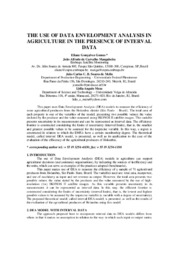The use of data envelopment analysis in agriculture in the presence of interval data.
The use of data envelopment analysis in agriculture in the presence of interval data.
Author(s): GOMES, E. G.; MANGABEIRA, J. A. de C.
Summary: This paper uses Data Envelopment Analysis (DEA) models to measure the efficiency of some agricultural producers from the Holambra district (São Paulo - Brazil). The total area of each property is one of the variables of the model, presenting two possible values: the value declared by the producer and the value measured using IKONOS II satellite images. This variable presents uncertainty in its measurement and can be represented as interval data. The efficiency frontier is constructed considering the limits of uncertainty (interval limits), that is, the smallest and greatest possible values to be assumed for the imprecise variable. In this way, a region is constructed in relation to which the DMUs have a certain membership degree. The theoretical model, called interval DEA model, is presented, as well as its application to the case of the evaluation of the efficiency of the agricultural producers of Holambra.
Publication year: 2004
Types of publication: Paper in annals and proceedings
Unit: Embrapa Territorial
Keywords: Data Envelopment Analysis
Observation
Some of Embrapa's publications are published as ePub files. To read them, use or download one of the following free software options to your computer or mobile device. Android: Google Play Books; IOS: iBooks; Windows and Linux: Calibre.
Access other publications
Access the Agricultural Research Database (BDPA) to consult Embrapa's full library collection and records.
Visit Embrapa Bookstore to purchase books and other publications sold by Embrapa.

